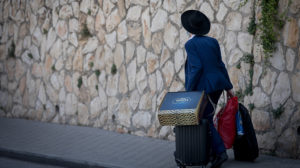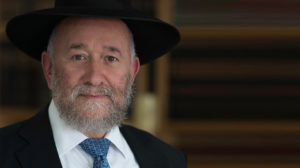This Is Our Victory


W hat’s more exhilarating than recalling a vort you said many years ago to explain a difficult pasuk or gemara?
When someone else reminds you of a vort he heard from you that you had long forgotten.
A number of years ago a former talmid now baruch Hashem the head of a family himself came to Chicago to spend Shabbos Chanukah with his parents. After Maariv of Leil Shabbos he approached me to offer his “Gut Shabbos Rebbi ” and proceeded to comment “I will never forget the vort Rebbi told us on the Rambam at the end of Hilchos Chanukah back in eighth grade.” That was some 20 years earlier! Who would have thought that anyone had paid attention even then let alone that he would recall it now!
The Rambam famously categorizes the mitzvah of ner Chanukah as chavivah ad me’od — extremely beloved. As anyone familiar with the Rambam’s works can attest he is hardly prone to hyperbole or superlatives. Clearly there is a unique dimension to this mitzvah that sets it apart from all others. The vort as recalled by my former talmid is as follows:
The Gemara teaches us (Yoma 29a) that Purim is sof kol hanissim the last of all miracles performed on behalf of Klal Yisrael. The Gemara challenges “But what about Chanukah?” (which occurred much later during the second Beis Hamikdash). The Gemara answers that Purim was the last miracle to be recorded in a formal sefer of Tanach. We see however that Chanukah was indeed “the last miracle ” albeit not one recorded scripturally for posterity.
Imagine having a correspondence with a dear friend or relative and exchanging letters over a period of time. Every single one is precious but nothing comes to the significance of the very last one you know you will ever receive. You check for nuances subtleties any hidden messages you can find because you know that your correspondent was equally aware that this was the very last one.
I fondly recall such a last encounter one that has stayed with me throughout the years. Before leaving Eretz Yisrael to continue my learning back in the States I traveled to Petach Tikvah to say a final farewell to my father’s rebbi the elderly Rav Yaakov Neiman ztz”l. I had visited this tzaddik yesod olam several times and I knew this would be the last meeting. So did he. Before we parted company he expressed that he had wanted to give me a copy of his sefer Pri Yaakov on Bava Kamma but he only had a few left to bequeath to his grandchildren. He stopped mid-sentence and exclaimed “Uber du bist oichet an einekel — You are also a grandchild!” and he tenderly kissed me while handing over a sefer. Whenever I learn Bava Kamma his is the first sefer I take off the shelf. Chaviv ad me’od because it came from the last moments I spent in his presence.
This is perhaps the uniqueness of ner Chanukah: it represents the very last communication we received publicly from Hashem. We cherish it and embrace it like no other; it is chavivah ad me’od. It behooves us then to look for the eternal message it contains. (Thanks Yaakov Koppel for the reminder!)
What is that last message we are to take from the neis of Chanukah? We may find a clue in an unusual aspect of ner Chanukah that we do not find in any other mitzvah.
The Gemara discusses how the mitzvah is to be performed: according to Beis Shammai we light eight candles on the first night and go down one each day and according to Beis Hillel we begin with one candle and add one each day. But this is the mehadrin min hamehadrin method of lighting. Another method which the Gemara categorizes as mehadrin is for the head of the household to light one candle per night per family member. How strange! Could we imagine a Pesach seder in which the baal habayis is the only one to eat matzah and is required to eat 20 k’zeisim if he has a large family? Or how about juggling ten lulavim and esrogim if he is blessed to have a family of ten? Can you envision 20 pairs of tefillin on one head if the same individual also wears Rabbeinu Tam?
Why should ner Chanukah be performed in such a fashion where the larger the brood the greater the number of candles?
An answer to this question struck me at the wedding of a grandchild of a dignified member of the she’eiris hapleitah. The zeide had served his time in the Gehinnom of this world before Hashgachah brought him to the United States and blessed him with a beautiful family and comfortable parnassah.
Witnessing the abundant pride and joy glowing from his face after the chuppah I approached to wish him mazel tov and asked him what was going on in the inner recesses of his mind and heart at that moment. His response was immediate: “This is my nitzachon [victory] over them. I won!”
Seforim quote the words of a midrash that gives a blow-by-blow account of the efforts that the Yevanim employed to destroy taharas Yisrael including abolishing mikvaos and subjecting engaged women to heinous acts of degradation. Their goal was to erase a nation built and sustained al taharas hakodesh but open miracles and great mesirus nefesh allowed us to persevere. The midrash relates that springs came bursting forth from beneath Jewish homes to ensure that our purity remained intact. Every Jewish child that was born b’taharah was living testimony to these miracles. And every such child was a victory over the Yevanim and their evil intent to destroy the taharah and kedushah of Am Yisrael.
Is it any wonder then that Chazal considered instituting that a candle be lit for every child in the family? Each candle represents a victory; every child born in a Yiddishe home is one more expression of netzach Yisrael lo yeshaker. To paraphrase my elderly friend “This is our nitzachon.”
Whatever the source for distributing Chanukah gelt may be and several have been suggested it is an ancient minhag Yisrael to shower our children with money on Chanukah. The Steipler Gaon ztz”l always dedicated the fifth night of Chanukah to this holy custom. (His son Rav Chaim shlita speculates that this is because the fifth night can never fall on Shabbos.) This too is a tradition unique to Chanukah perhaps once again to reinforce our feelings of thanks to Hashem for allowing us to retain our mesorah of bringing children into the world bikdushah u’v’taharah.
This may explain why the Chanukah story is not “written ” as opposed to the Purim Megillah. A book has an end to the story. Whether it is Megillas Esther or l’havdil Moby Dick the story ends with the last chapter. But Chanukah is about a perpetual struggle the war of kedushah versus tumah. There is no final chapter — yet. It is incumbent upon us to keep fighting the good fight for as soon as we let our guard down the tumah streams right in. It is the eternal spiritual struggle of Yisrael versus Yavan the progenitor of Western culture.
Perhaps we can use this opportunity to transmit to our precious next generation the central focus of our celebration as tehorim. In the decadent world in which we live in we can never say enough to reinforce the message that our role and purpose of existence is to retain that taharah.
And for those who have embraced the newfangled practice of giving Chanukah gifts we should never allow modern culture to influence the gifts we give. It is the antithesis of the Yom Tov we are celebrating when the gift represents acceptance of secular culture rather than our victory over those who tried to foist it upon us.
This is what Chanukah is truly about. This is the precious last correspondence we were zocheh to receive from Hashem before we descended into our long dark galus surrounded by the enticements of the culture around us.
Through neis Chanukah Hashem sent us His final message: As long as we are committed to live our lives in taharah Hashem will shower us with His love and watch over us His banim chavivim who celebrate annually this mitzvah chavivah.
Originally featured in Mishpacha Issue 689. Rabbi Henoch Plotnik is the mara d’asra of Congregation Bais Tefila and a ram in Yeshivas Meor Hatorah in Chicago.
Oops! We could not locate your form.













